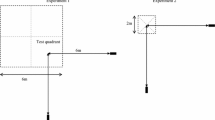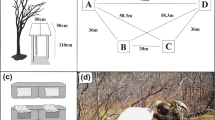Abstract
Locating food and refuge is essential for an animal's survival. However, little is known how mammals navigate under natural conditions and cope with given environmental constraints. In a series of six experiments, I investigated landmark-based navigation in free-ranging Columbian ground squirrels (Spermophilus columbianus). Squirrels were trained individually to find a baited platform within an array of nine identical platforms and artificial landmarks set up on their territories. After animals learned the location of the food platform in the array, the position of the latter with respect to local artificial, local natural, and global landmarks was manipulated, and the animal's ability to find the food platform was tested. When only positions of local artificial landmarks were changed, squirrels located food with high accuracy. When the location of the array relative to global landmarks was altered, food-finding accuracy decreased but remained significant. In the absence of known global landmarks, the presence of a familiar route and natural local landmarks resulted in significant but not highly accurate performance. Squirrels likely relied on multiple types of cues when orienting towards a food platform. Local landmarks were used only as a secondary mechanism of navigation, and were not attended to when a familiar route and known global landmarks were present. This study provided insights into landmark use by a wild mammal in a natural situation, and it demonstrated that an array of platforms can be employed to investigate landmark-based navigation under such conditions.




Similar content being viewed by others
References
Alyan S, Jander R (1994) Short-range homing in the house mouse, (Mus musculus) stages in the learning of directions. Anim Behav 48:285–298
Balda RP, Kamil AC, Grim K (1986) Revisits to emptied cache sites by clark nutcrackers (Nucifraga columbiana). Anim Behav 34:1289–1298
Bennett ATD (1993) Spatial memory in a food storing corvid.1. near tall landmarks are primarily used. J Comp Physiol A-Sens Neural Behav Physiol 173:193–207
Biegler R, Morris RGM (1996) Landmark stability: further studies pointing to a role in spatial learning. Q J Exp Psychol Sect B-Comp Physiol Psychol 49:307–345
Bingman VP (1998) Spatial representation and homing pigeon navigation. In: Healy S (ed) Spatial representation in animals. Oxford University Press, Oxford, pp. 69–85.
Brodbeck DR (1994) Memory for spatial and local cues a comparison of a storing and a nonstoring species. Anim Learn Behav 22:119–133
Cheng K (1989) The vector sum model of pigeon landmark use. J Exp Psychol-Anim Behav Process 15:366–375
Cheng K, Spetch ML (1998) Mechanisms of landmark use in mammals and birds. In: Healy S (ed) Spatial representation in animals. Oxford University Press, Oxford, pp 1–17.
Chittka L, Geiger K (1995) Can honey-bees count landmarks. Anim Behav 49:159–164
Collett TS, Cartwright BA, Smith BA (1986) Landmark learning and visuospatial memories in gerbils. J Comp Physiol A-Sens Neural Behav Physiol 158:835–851
Day TA, Detling JK (1990) Grassland patch dynamics and herbivore grazing preference following urine deposition. Ecology 71:180–188
Devenport JA, Devenport LD (1994) Spatial navigation in natural habitats by ground-dwelling sciurids. Anim Behav 47:727–729
Festa-Bianchet M, Boag DA (1982) Territoriality in adult female Columbian ground squirrels. Can J Zool 60:1060–1066
Fiset S, Dore FY (1996) Spatial encoding in domestic cats (Felis catus). J Exp Psychol-Anim Behav Process 22:420–437
Fiset S, Gagnon S, Beaulieu C (2000) Spatial encoding of hidden objects in dogs (Canis familiaris). J Comp Psychol 114:315–324
Gaulin SJC (1993) How and why sex differences evolve, with spatial ability as a paradigm example. In: Haug M, Whalen RE, Aron C, Olsen KL (ed) The development of sex differences and similarities in behavior. Kluwer Academic Publishers, Dordrecht, pp 111–130.
Healy SD, Hurly TA (1998) Rufous hummingbirds' (Selasphorus rufus) memory for flowers: patterns or actual spatial locations? J Exp Psychol-Anim Behav Process 24:396–404
Henderson J, Hurly TA, Healy SD (2001) Rufous hummingbirds' memory for flower location. Anim Behav 61:981–986
Jacobs LF, Schenk F (2003) Unpacking the cognitive map: the parallel map theory of hippocampal function. Psychol Rev 110:285–315
Jacobs LF, Shiflett MW (1999) Spatial orientation on a vertical maze in free-ranging fox squirrels (Sciurus niger). J Comp Psychol 113:116–127
Leonard B, McNaughton BL (1990) Spatial representation in the rat: conceptual, behavioral, and neurophysiological perspectives. In: Kesner RP, Olton DS (eds) Neurobiology of comparative cognition. Lawrence Erlbaum. Hillsdale, NJ, pp 363–422.
Menzel R, Brandt R, Gumbert A, Komischke B, Kunze J (2000) Two spatial memories for honeybee navigation. Proc R Soc Lond Ser B-Biol Sci 267:961–968
Murie JO, Harris MA (1988) Social interactions and dominance relationships between female and male Columbian ground-squirrels. Can J Zool-Rev Can Zool 66:1414–1420
Neuhaus P, Pelletier N (2001) Mortality in relation to season, age, sex, and reproduction in Columbian ground squirrels (Spermophilus columbianus). Can J Zool-Rev Can Zool 79:465–470
Shettleworth SJ (1998) Cognition, evolution, and behavior. Oxford University Press, New York
Suzuki K, Kobayashi T (2000) Numerical competence in rats (Rattus norvegicus): Davis and Bradford (1986) extended. J Comp Psychol 114:73–85
Suzuki S, Augerinos G, Black AH (1980) Stimulus-control of spatial-behavior on the 8–arm maze in rats. Learn Motiv 11:1–18
Tolman EC (1948) Cognitive maps in rats and men. Psychol Rev 55:189–208
Wallraff HG (2001) Navigation by homing pigeons: updated perspective. Ethol Ecol Evol 13:1–48
Williams CL, Meck WH (1993) Organizational effects of gonadal hormones induce qualitative differences in visuospatial navigation. In: Haug M,Whalen RE, Aron C, Olsen KL (eds) The development of sex differences and similarities in behavior. Kluwer Academic Publishers, Dordrecht, pp 175–189.
Acknowledgements
I am grateful to Dorothy L. Cheney for her support, helpful discussions of the experiments, and valuable comments on the manuscript. I am thankful to Arthur E. Dunham for his support of the project. I would like to thank Sara J. Shettleworth, Brett M. Gibson, Marcia L. Spetch, Alan C. Kamil, anonymous reviewers for valuable comments on the earlier versions of the manuscript, Ken Cheng for helpful discussion of the experiments, and Peter S. Petraitis for suggestions on statistical analysis. Many thanks are due to F. Stephen Dobson for teaching me how to work with the animals, allowing to perform experiments at his study site, logistical support on the field, and comments on the manuscript. I extend my thanks to Morgan King for helping with the platform construction. This research adheres to the legal requirements of Alberta Sustainable Resource Development organization, and the Life and Environmental Sciences Animal Care Committee of the University of Calgary, Canada. This research was partially supported by a National Science Foundation grant to F.S. Dobson (#DEB-0089473)
Author information
Authors and Affiliations
Corresponding author
Rights and permissions
About this article
Cite this article
Vlasak, A.N. Global and local spatial landmarks: their role during foraging by Columbian ground squirrels (Spermophilus columbianus). Anim Cogn 9, 71–80 (2006). https://doi.org/10.1007/s10071-005-0006-3
Received:
Revised:
Accepted:
Published:
Issue Date:
DOI: https://doi.org/10.1007/s10071-005-0006-3




